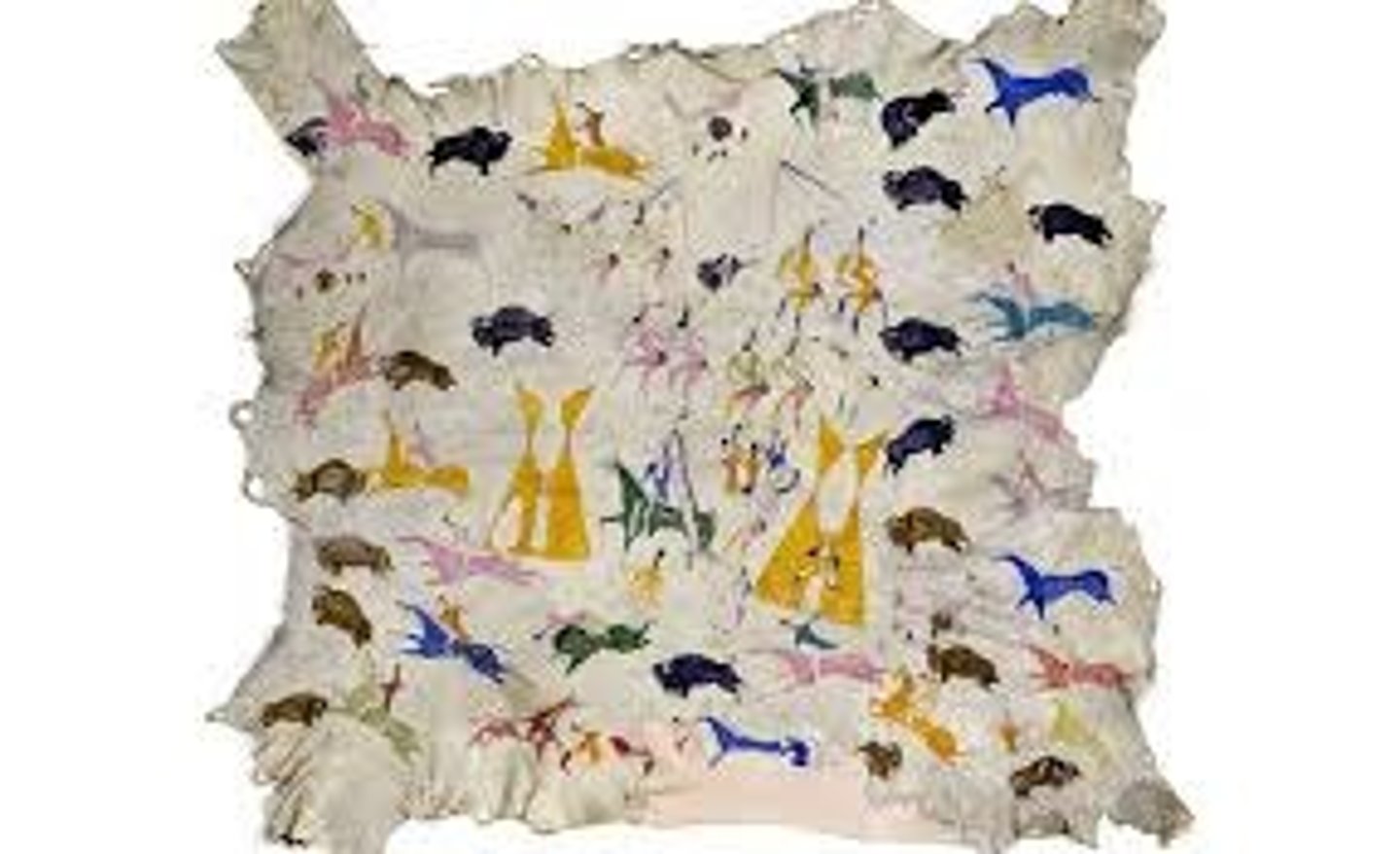APAH Unit 2 Artworks- Indigenous America Artworks (Cards 23- 36, Templo Mayor- Hide Painting of the Sun Dance) Identifiers + FFCC
1/13
There's no tags or description
Looks like no tags are added yet.
Name | Mastery | Learn | Test | Matching | Spaced |
|---|
No study sessions yet.
14 Terms
Templo Mayor, Tenochtitlan, Mexico, 1375-1520 C.E.; Coyoxauhqui Stone, c. 1500, found at Templo Mayor; Olmec-style mask, c. 1470, found at Templo Mayor
Templo Mayor
Form- 90 ft tall, Elevated temple, large scale, center of Aztec Capital Tenochtitlan, Isolated w small minor temples nearby, Orientation of an Axis Mundi (4 quadrants) in center of the Universe, Very Precise, Two temples at the top of elevated steps, has a chacmool (sacrificial stone) in front of both, has lots of serpent imagery
Function- Held Ceremonies and Rituals, specifically Human Sacrifices, and was a symbol of the empires Power.
Content- The 4 Quadrants= Earth, Wind, Fire, and Water, Pyramid relates to Sacred Mount Coatepec, During winter/summer equinoxes sun rose between the two temples. Left side temple is for Tlaloc- The Rain God, primarily referenced with frogs. Right side temple is for Huitzilopochtli- the Deity of the Sun and Warriors, Coyolxauqui Stone is under the right side or the Foot of Coatepec
Content- The Quexacotl, or sacred feathered serpent, is the sacred animal of the Aztecs and heavily used in the temple. Temple was destroyed in Spanish conquest, stores used to build churches. Huitzilopochtli came from Coatepec, his mother Coatlicue conceived him from a feather and he formed to protect her from his sister, Coyolxauqui.
Coyolxauqui Stone
Form- Monolith, Head, and body lays at unnatural angles, Dismembered body parts, overhead perspective, Nude figure with folds on the belly and sagging breasts (shows her as a mother), Snake belt and snakes wrapped around her limbs, dressed in skulls, headdress, and armbands
Function- Prisoners of war and sacrificial men were painted blue to represent the brothers of Coyolxauqui and chased off the side of the top of the Huitzilopochtli Temple, stone showed the temple's meaning and portrayed the violece the Aztecs would use upon their enemies
Content- Coyolxauqui- bells in her cheeks, wearing battle dress as she was coming with her army to kill Coatlicue and her unborn brother
Context- Coyolxauqui was Huitzilopochtli's sister and was upset at her mother's new heir, brought 400 brothers to storm Mount Coatlicue. Her mother rallied Huitzilopochtli and he formed in battle armor and weaponry. He sliced off her head and threw her off the mountain, her body shattering at the foot of the mount.
Olmec-
Form- Style Mask- Made 1000 years prior to Tenochtitlan
Function- Buried as an offering
Content- Not Aztec, either transported as offering or stolen after war
Context- Jaguar-esque, Jaguars were vital to Olmec art/culture
Calender Stone (Aztec Sun Stone) Form- Very detailed, deep carving Function- Mainly a sacrifical altar. Content- Depicts either the Sun God (Tonatiuh) or the Earth God (Tlaltecahtli) in the central circle, likely Tlatechatli due to his tounge being shown (he had a flint tongue). The clawed hands of the Night Sun from the underworld on the right and left of the central circle. Only contains 20 of the 260 days of the ritural calender. Called the Sun Calender due to the calender itself appearing like the Aztec symbol for the sun and rays (a circle with pointed trangles representing the rays) The stone is divided into 4 ages or 4 suns. When one ends a new one begins. Four specific rectangles around the main central circle represent: 4 Jaguar, 4 Wind, 4 Rain and 4 Water. The God is likely the 5th Sun, which came about when the Weakest God self-sacrificed by throwing himself into a fire. He refused to go across the sky unless he was presented gifts equal to his own death (hence human sacrifices = Sun = Life!)
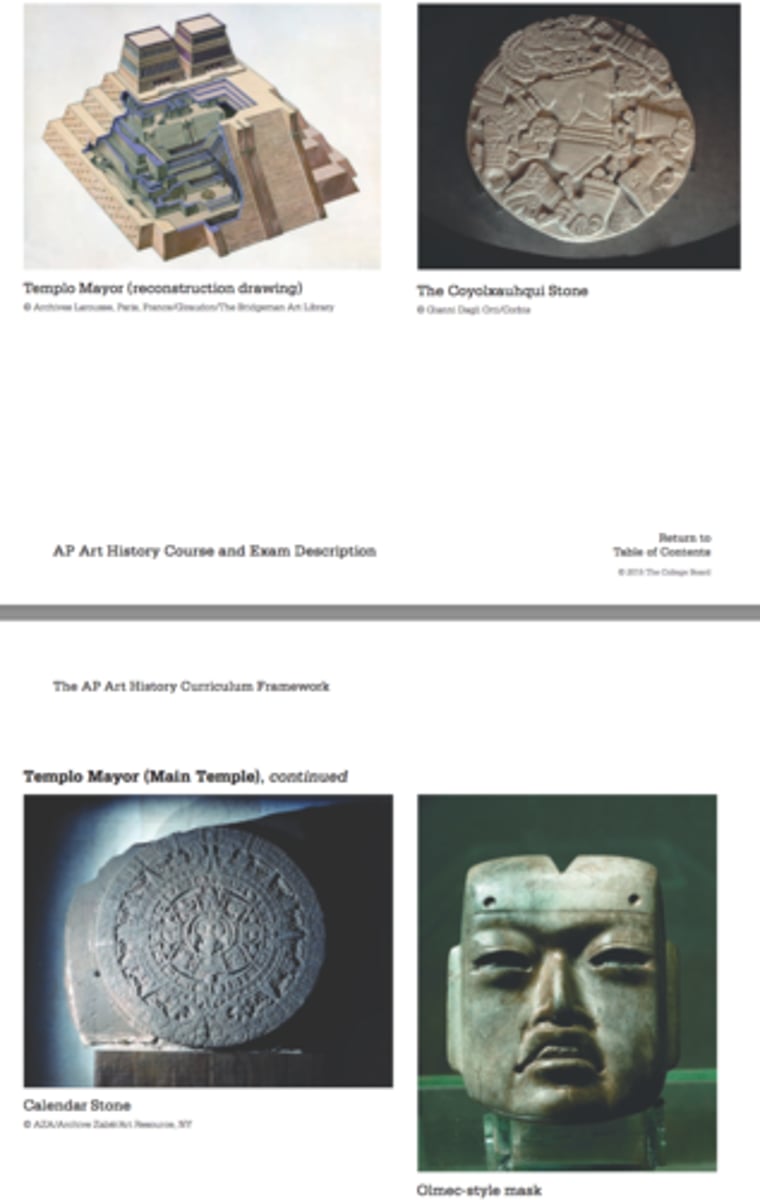
Great Serpent Mound
Adams County, southern Ohio. Mississippian (Eastern Woodlands). c. 1070 C.E. Earthwork mound, Fort Ancient Culture (?)
Form- About 1/4 of mile in length, Clay or ash with rocks piled on top and then covered in soil, Varies in height (4-5 ft in places) and width (20-25 ft)
Function- Unclear, Likely sacred or supernatural site, Theory: Made 4 years after brightest appearance of Haley's comet, comet lead to building mound in 4 years.
Content- Head of snake faces the Summer Solstice sunset, no graves or artifacts found on site.
Context- Created around 1070, based on dating, Indigenous groups have traditions around the site, view it as a spiritual pathway. Mississippi Natives constructed large effigy mounts in the shape of animals/
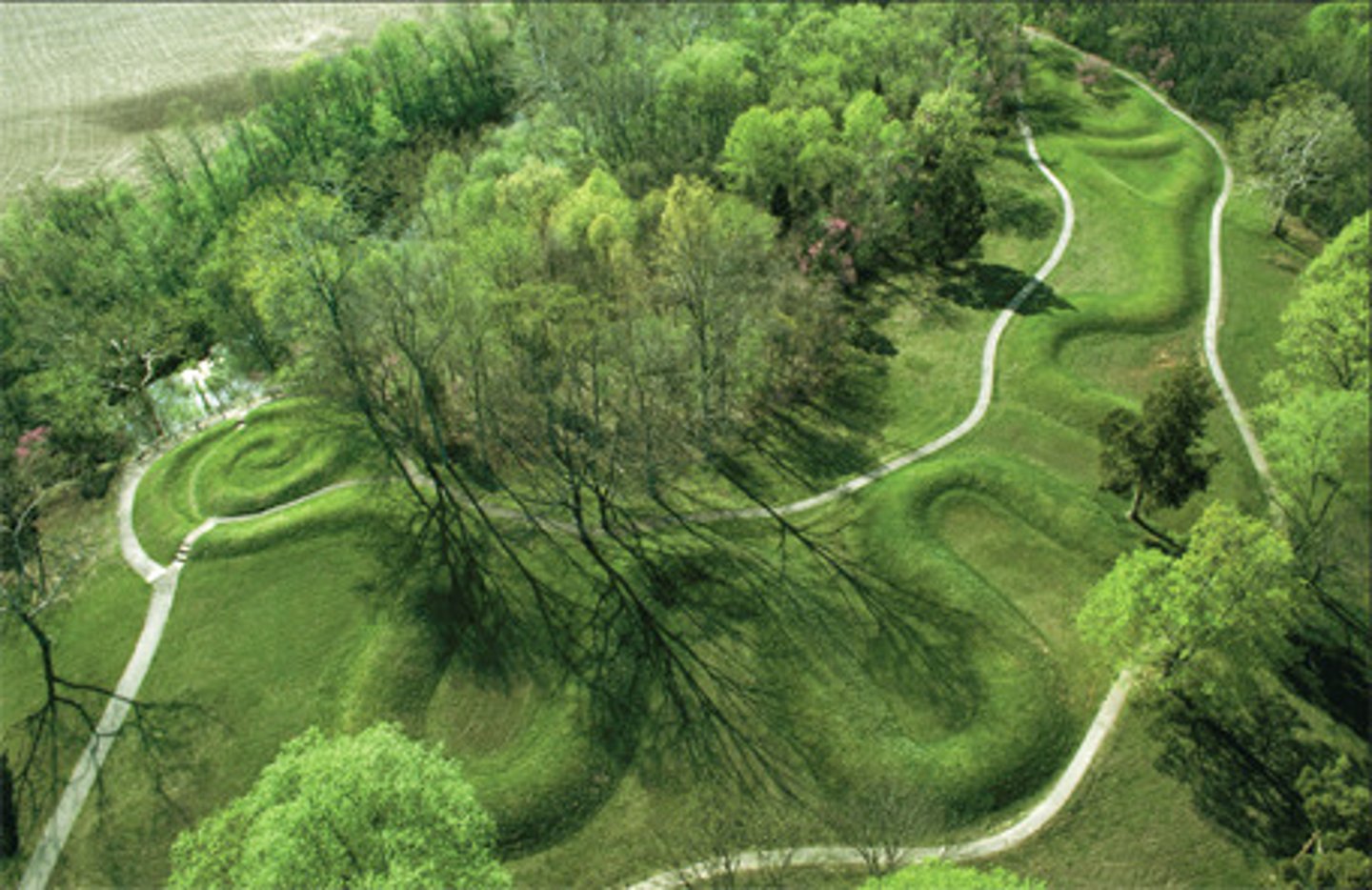
Black-on-black ceramic vessel
Maria Martinez and Julian Martinez, Tewa, Puebloan, San Ildefonso Pueblo, New Mexico. c. 1939 C.E. Blackware ceramic , 11 1/8 x 13 inches
Form- Intricate geometric design. Patterns formed out of negative space. Materials: Pueblo-an pot making= Communal, Everyone does something.
Maria sculpted, Julian decorated, No wheel used, coil method. Julien decorates with slip (water and clay) making it black on black. Use red clay, firing turns clay & slip black.
Function- Special occasions, used for serving and cooking, here Purely decorative.
Content- Similar to cave paintings in Mesa Verde. Stylized depictions of natural items- Corn, rivers, and feathers.
Context- Pottery by Ancestral Pueblo-ans for 100,000 + years. Intro. of Railroads (around late 1800s) lead to: Metal pots= available and kill off ceramic for Pueblo-ans, stops usage of traditional pots. Tourists came into New Mexico. this lead to pots no longer being utilitarian, now used for tourism and preserving heritage.
Maria & Julian Martinez- Go outside the Pueblos (Worlds Fair) and sell their pottery as Fine Art. More people see them & collect them, adding distance from conteext but spreads it as a technique and piece. Pueblo-ans produce pottery and turqouis for money and hese fine art collectors.
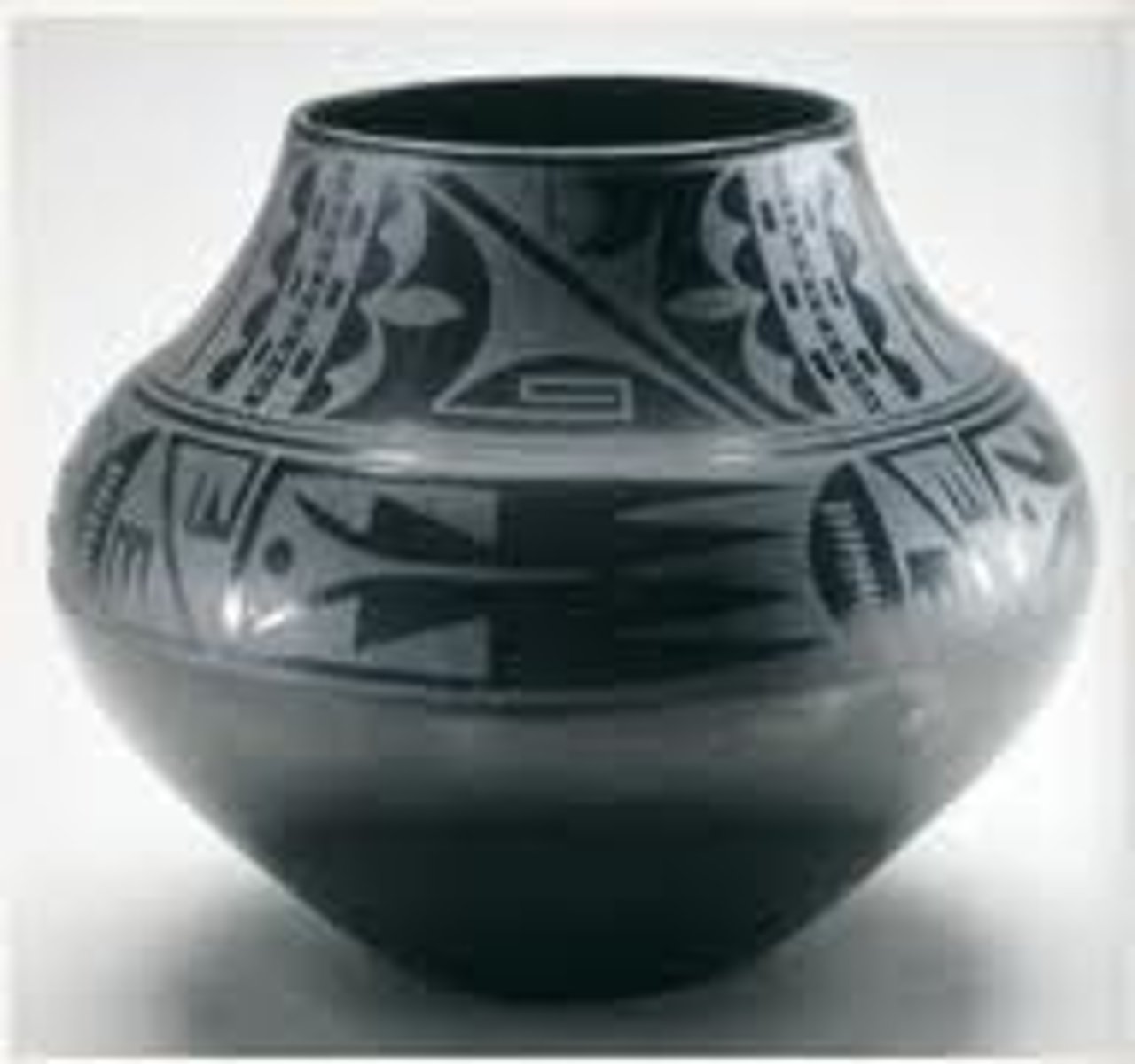
Chavin de Huantar. Northern highlands, Peru. Chavin 900-200 bce. stone (architectural complex), granite (Lanzon and sculpture), hammered gold alloy (nose ring and jewelry).
Chavin
Form- Made of Stone, granite, New and old temple, both similar, Elevated space, grows smaller and more sacred, less populated. Multi-level, sunken plaza and elevation makes the temple grow in view. Private, dark temple with narrow hallways to Lanzon (large sphere)
Placed in the Center of temple hallways, 16 ft tall, temple was possibly built around the Lanzon. Built from floor to ceiling, may represent heaven and underworld. Uses Contour Rivalry- Optical Illusion, Idea of seeing two images in a singular image.
Function- Ritual, worship, and ceremony. Priest of Chavin used removable stones to talk to those inside or scare them with horns and sounds, created a sense of fear and disorientation that made them vulnerable to their influence. Would also use speaking above the Lanson and tubes inside of it to make it bleed and appear to speak/inhabit a god who spoke to the subject.
Content- Lanzon: Symmetrical Face/Body, Gesturing up and down (ala Baphomet) References to human female w feline head (Jaguar), multiple Jaguar heads in 'headdress' at different angles, eyelashes or whiskers around eyes end in serpents, Earrings, signs of wealth, Clawed hands and feet, Channel through the top of the face for 'liquid offerings' (blood)
Context- Before going into the temple, the person was given a hallucinogen that induced trance-like state to disorient. Chavin= 2,500 years older than Inca. Found offerings inside complex (trumpet shells (likely used in the ritual as well) and the nose ring, hammered gold snake) in the temple. Chavin-only society to have complex, sophisticated visual effects in stone artwork.
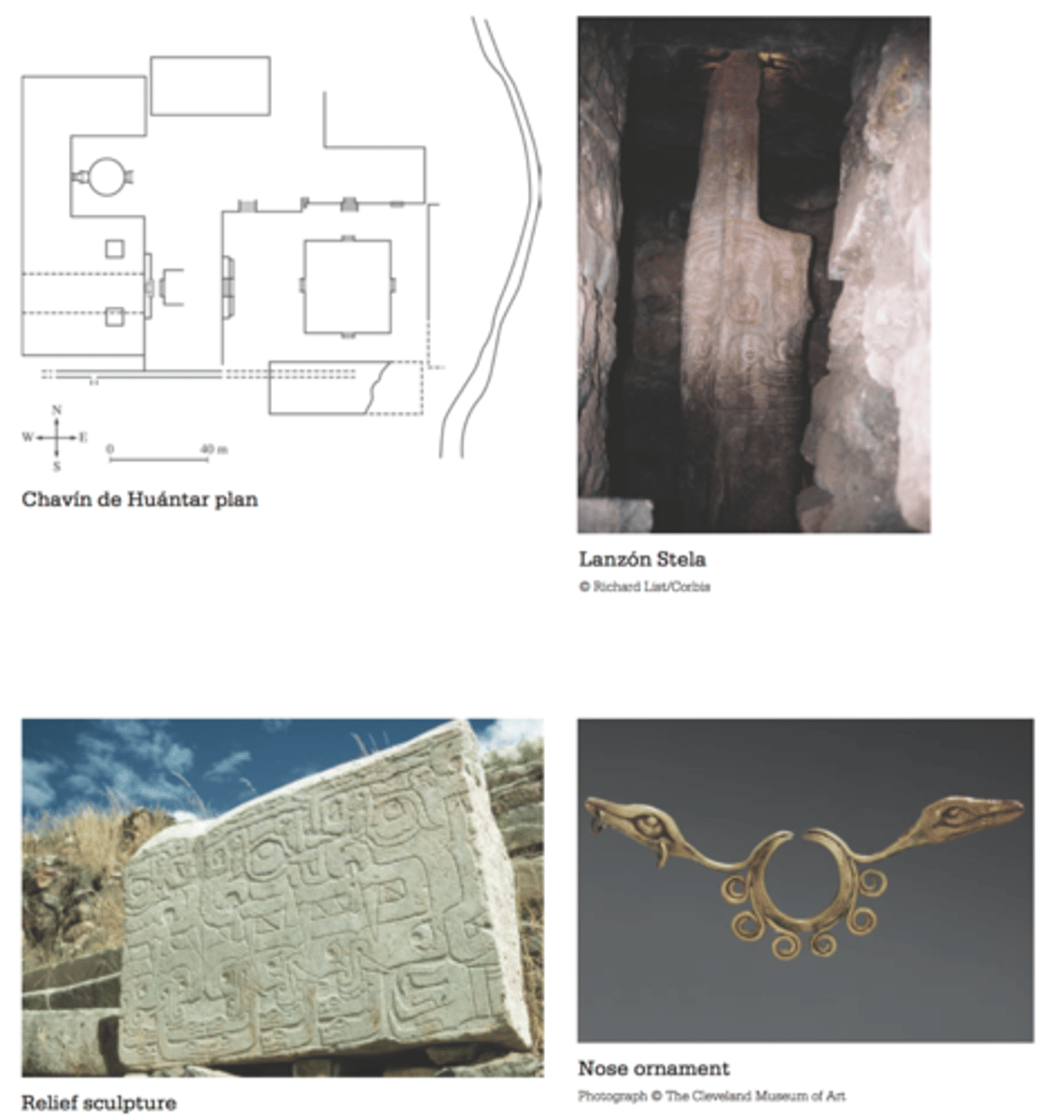
Bandolier bag
Lenape (Delaware tribe, Eastern Woodlands). c. 1850 C.E., hide, cotton cloth, silk ribbon, glass beads, wool yarn, and metal cones
Form- Bright colors, very decorative, Cross body bag with long strap. Fringed (long, short). Symmetrical pattern with color shift, highly complex. Bead-work-Seed beads, individually sewed glass beads on leather backing.
Function- Decorative, Purely decorative element worn by men for festivals and special occasions. Made by women to be worn by men on important occasions. Resembles ammunition pouches, worn by hunters during the introduction of guns.
Content- No symbolism or Imagery in patterns. European-esque motifs.
Context- Colonials: From 1850, Indian Removal act (1830). Bags became expressions of Native identity and acts of defiance, through the 19th century to current time. Originally made with dyed porcupine quills with leather and animal sinew (pre-contact), After contact: bags changed to tiny (Venicen) glass beads with cotton threads on cotton cloth from trade with Europeans and Motif change, Canadian nuns taught embroidery, specifically Euro-floral motifs.

Yaxchillan, Lintels 24 and 25, Structures 23, 33, 40.
Maya, Chiapas, Mexico
Yaxchillan-Comed roof, decorative, Stairs into temple, Burial space for Monarchs
Form-Lintels- found above doorways in Yaxchillan, would walk in and see them overhead. Figures of high wealth (clothing/staff). Glyphs. Relief carving, carved directly into stone, raised image. Structure 23 was built as a burial site for her and her husband Shield Jaguar.
Function- Narrative. Legitimized King Shield Jaguar as King, ancestors vision accepted him. Shows Lady Xoc as able to speak with gods, married to the man they've ordained.
Content-Lintel 24, Structure 40: Bloodletting ritual, Induced hallucinations, and visions of ancestors. Depicts Shield Jaguar holding a flaming torch, cutting Lady Xoc's tongue on a thorny vine. Stance is meant to be royal, he is legitimizing his rule.
Lintel 25, Structure 30: Vision of Lady Xoc, Serpent winding out with an open maw and an emerging figure above her, pointing spear at Xoc's head, Xoc holds a bloodletting bowl, the serpent emerges from the blood-soaked cloak, flaming shield or spear shows the warrior's strength.
Obsiden knifes and bloodletting tools found at Xoc's alter
Context- Lady Xoc showed his ability to speak to Gods, legitimized her husbands rule and her power at the same time.
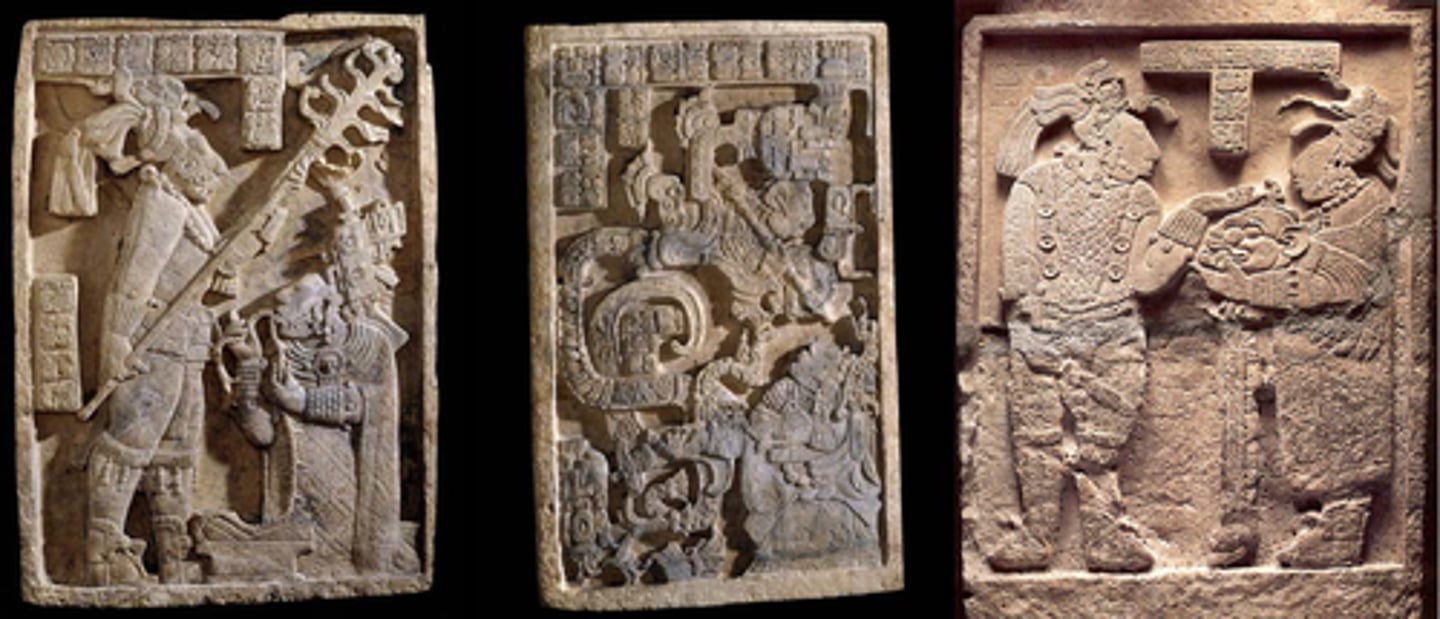
All-T'oqapu tunic
Inka. 1450-1540 C.E. Camelid fiber and cotton
Form- Distinctive patterns, some repetition, spread out. Very geometric overall. Hand made, still in Andean cultures. 300 threads per inch.
Function- Communicated social rank, nobility, social status, identity or marital status. Each square represents a tunics other societies would wear to show what they ruled over. Used as political gifts (textiles in general) to strengthen bonds and offers as sacrifices.
Content- Red dye from Cochineal. Textiles= extremely sacred and used as currency. Red or Blue were only used in elite's textiles. Patterns were all symbols of specific societies.
Context- Exclusively made by women. Weaving was a sacred art, had a Spider based deity (yay!) Women weavers were chosen to weave for royals and elites.
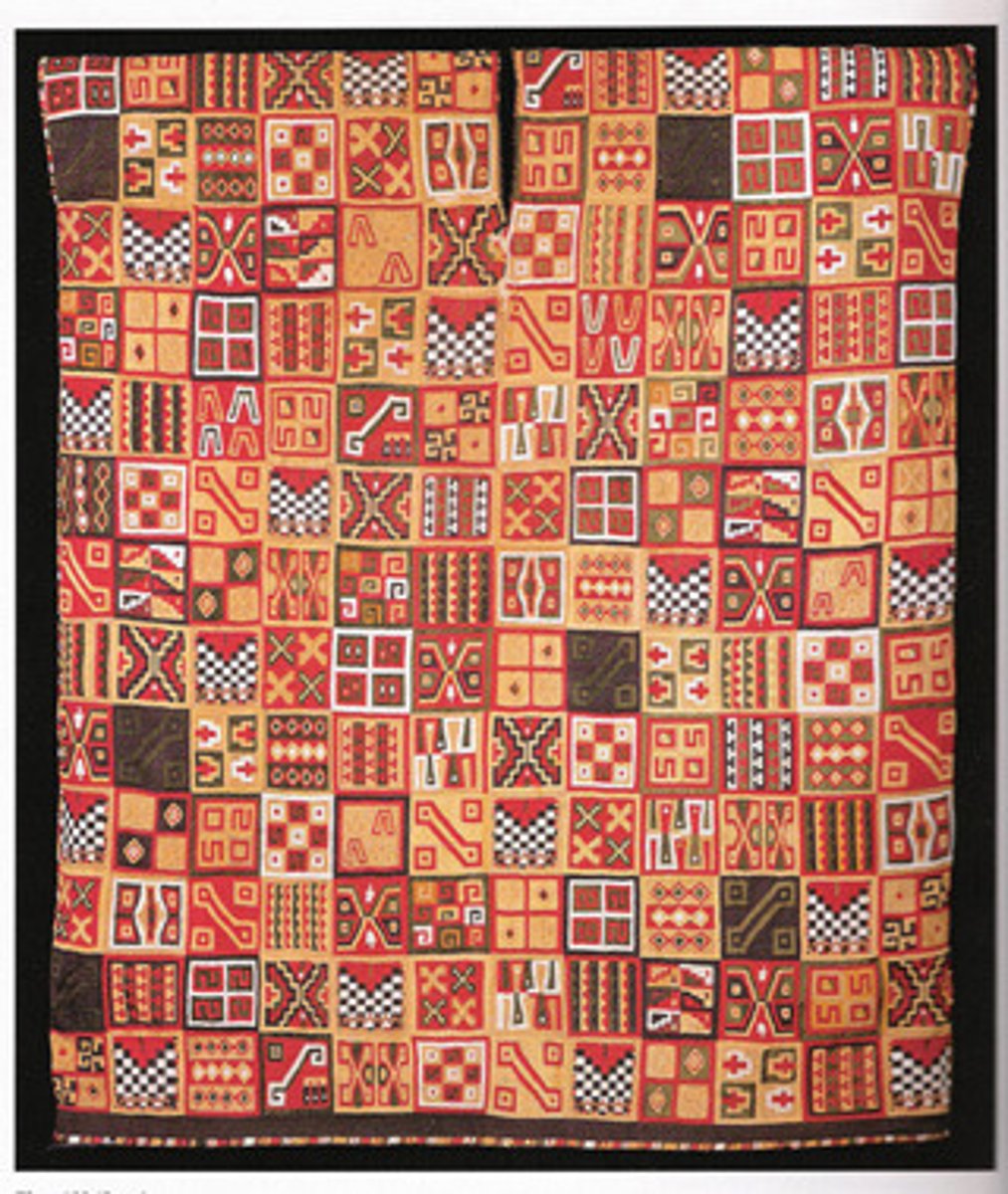
Eagle Mask
Kwakwaka'wakw artist, late 19th century c., from Alert Bay, Vancouver Island, British Columbia, Canada. Ceder wood, feathers, sinew, cord, bird skin, hide, plant fibers, cotton, iron, pigments.
Form- Specific patterning & red,black and white color scheme. Made of wood. Outside- Bird (beak and feathers, large eye) Inner- Semi-human face, split sides of the bird face painted inside. Pull strings visible.
Function- Mask has the power to transform its wear into the animal, Ancestor/Animal spirit. Ritual performances with transformation masks, Dancing brings the ancestors into the ritual by firelight.
Content- Animal and Human hybrids, Each Kwakwaka'wakw has an animal claimed to descent- here an eagle. Other clans can not use their animal imagery.
Context-Potlatches (Potluck original- Big, winter harvest with food and elaborate gift giving. Wealthy head gives away gift to redistribute the wealth and earn respect from his people.
Believed birds, fish, mammals were all the same but had different forms, animals can transform into any form. In origin myths, their ancestors shed animal skin to be human.
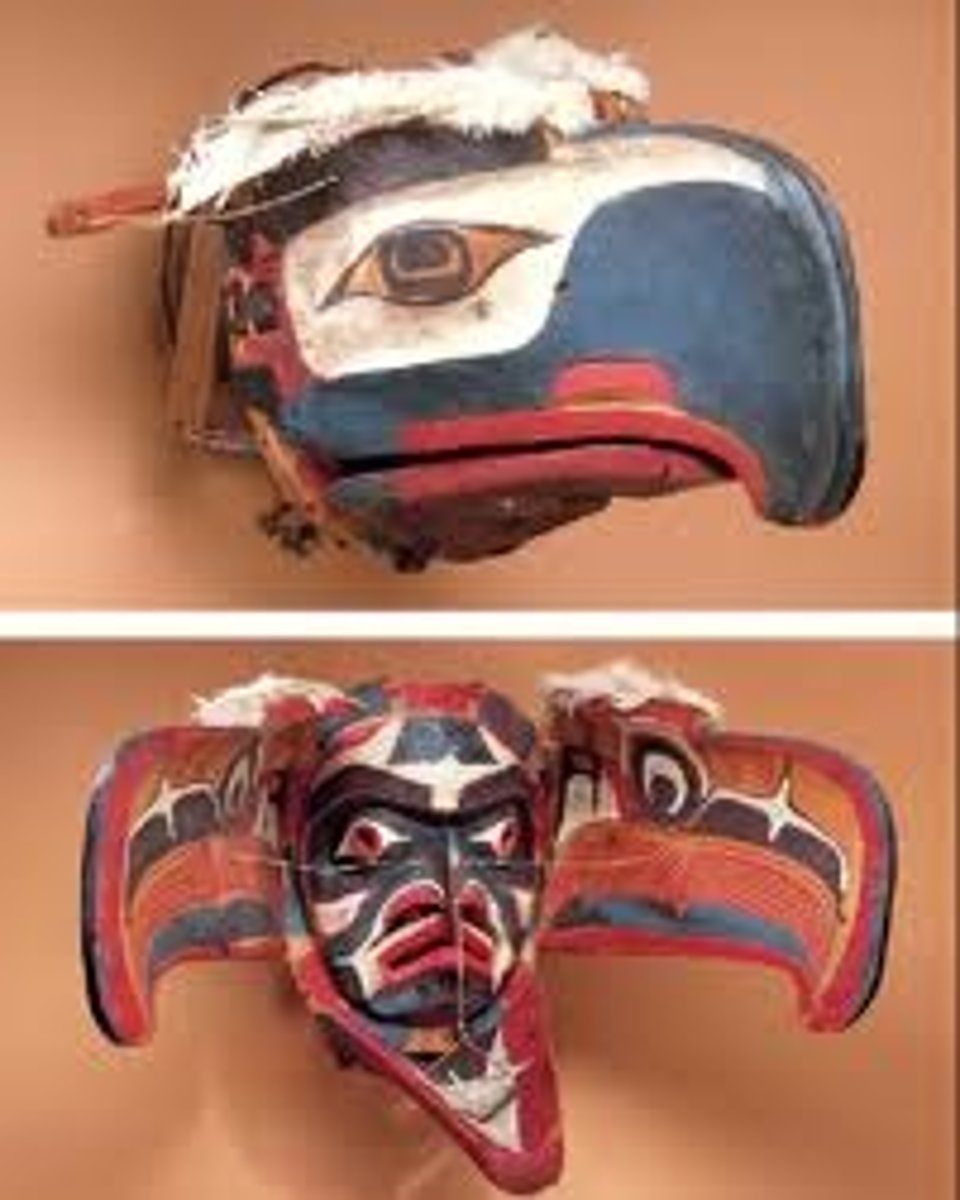
Feathered Headress
Aztec, reproduction (National Anthropology Museum, Mexico City). Original: Early 16th century, quetzal, cotinga, roseate spoonbill, and piaya feathers, wood, fibers, amate paper, cotton, gold, and guilded brass. Aztec, Mexico.
Form- Primarily bright green and blue feathers. Arch shape with central piece. gold beads. Thin, layered feathers. 3 ft tall, 69" wide, makes an average person about 9ft tall. Over 450 tail feathers.
Function- Used to mark rulers, Believed to originally belong to Montezuma (last great Aztec king)
Content- Made of Quetzal feathers, relates to Quetzalcoatl, the feathered snake. Contains gold, shells and quetzal tail feathers- all very valuable. Turquoise feathers were from Cotinga birds.
Context- Feathers were brought as tribute to leaders. Quetzal feathers and gold: Most important items in Mesoamerica. Headdress sent to Spain by Cortez. Spanish commissioned Codexes, recorded the construction of headdresses. Feather-workers were called Amanatecas.
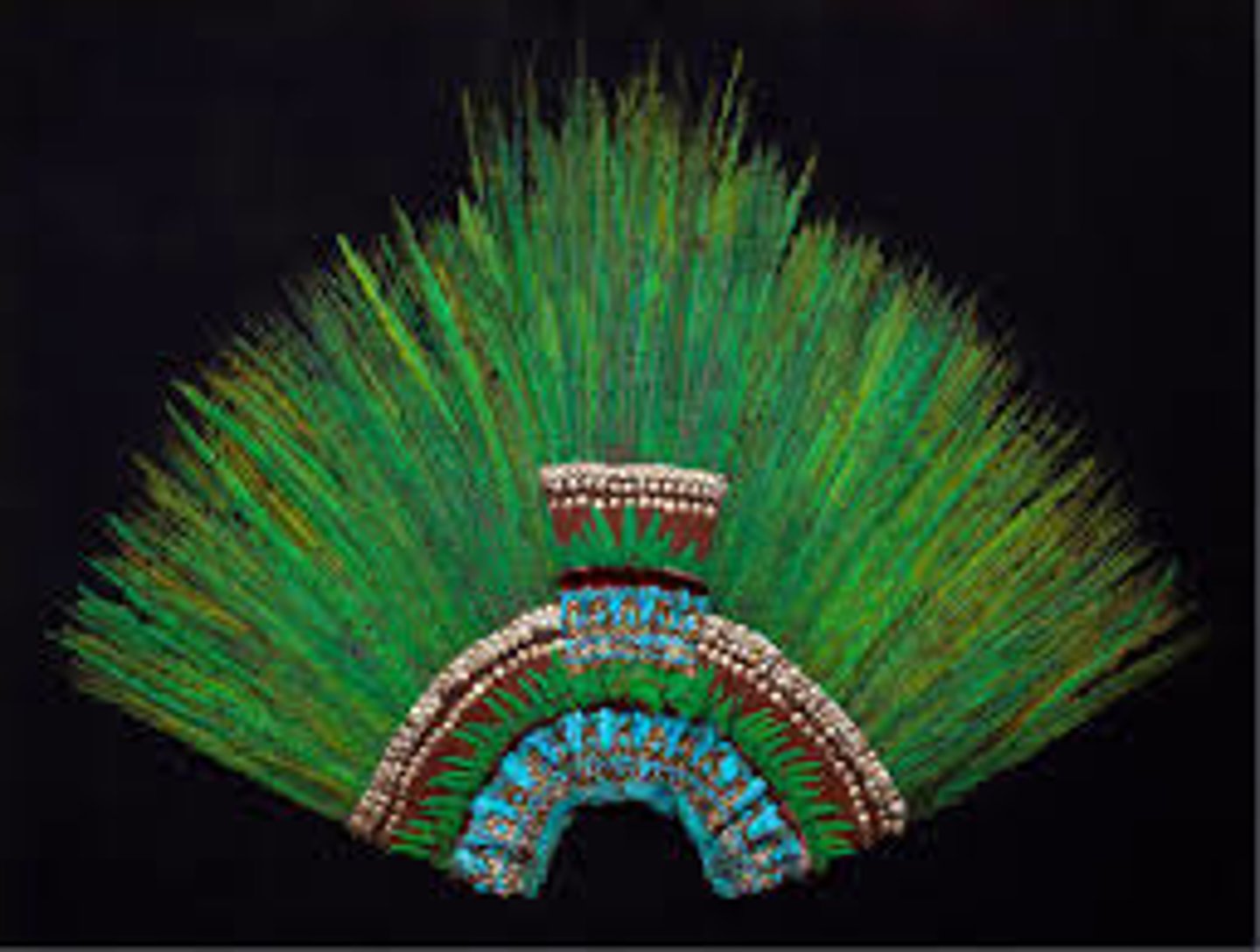
Machu Picchu
Peru, c. 1450-1540, Inka
Form- Complex at top of mountain, isolated and elevated. Show of using nature for their people. Sheer labor: cut stairs in Mountain, stone buildings and raised fields. Stone masonry. Populous of 500. Highest point was called Intevana-Stone connected to the Sun. No mortar used to build site/no glue, stone's cut so precisely they need no mortar. Buildings had thatched roofs. Conformed to the shape of the mountain, 200 terised fields.
Function- Stabilizes mountain from rock slides. Farmland at Picchu, raised terris, for maize. Irrigation system using mountain springs. Royal Estate (Pachucuti): Hosted feasts, ceremonies and ruled from Picchu.
Content- Devoted to the Sun God, Mountains considered sacred. Farmed at Pichu, maize for food and pulque (an offering to nobles)
Context- Lived warfree. Inca were sun worshipers, Picchu built for Sun worship.
Intihuana-Stone connected to Sun, Sundial-esque, for ceremony, At highest point, 2 windows, winter = left, summer = right
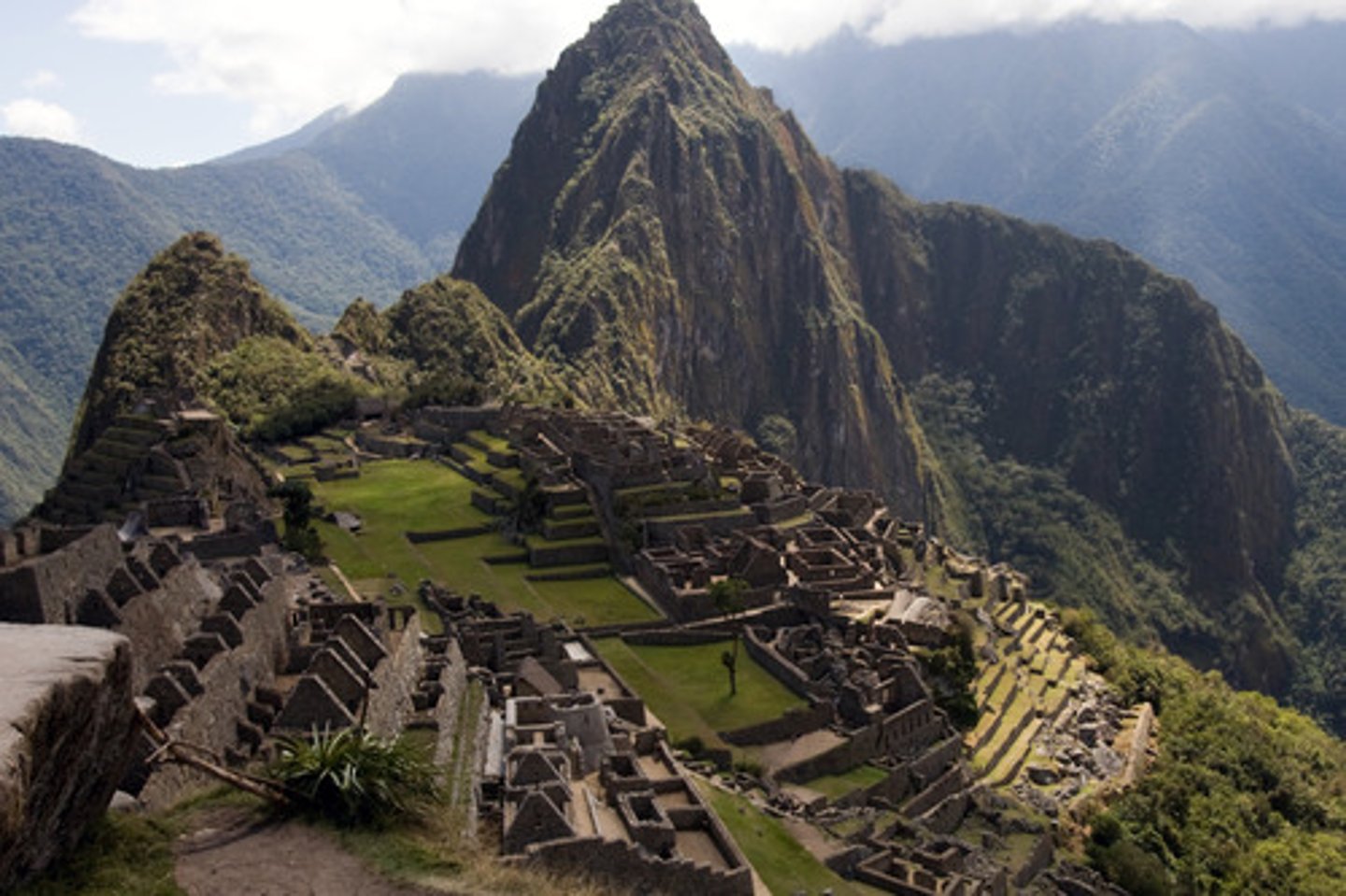
Maize cobs.
Inka. 1440-1533. ce. sheet metal/repousse, metal alloys
Form- Made of thin sheets of metal. Repousse-Pressing detail into metal with sharp tools. Veins in corn shucks, kernels on cobs. Silver alloy. Life sized 10"-12"
Function- Possible used in ritual, in Cuzco garden
Content- Maize is most important crop for Incas. Metal (especially gold) was valued for its reflective quality, similar to the sun.
Context- Metallurgy is common to region. Found in Qorikancha, garden completely made of silver and gold with miniture llamas and people made of metal.
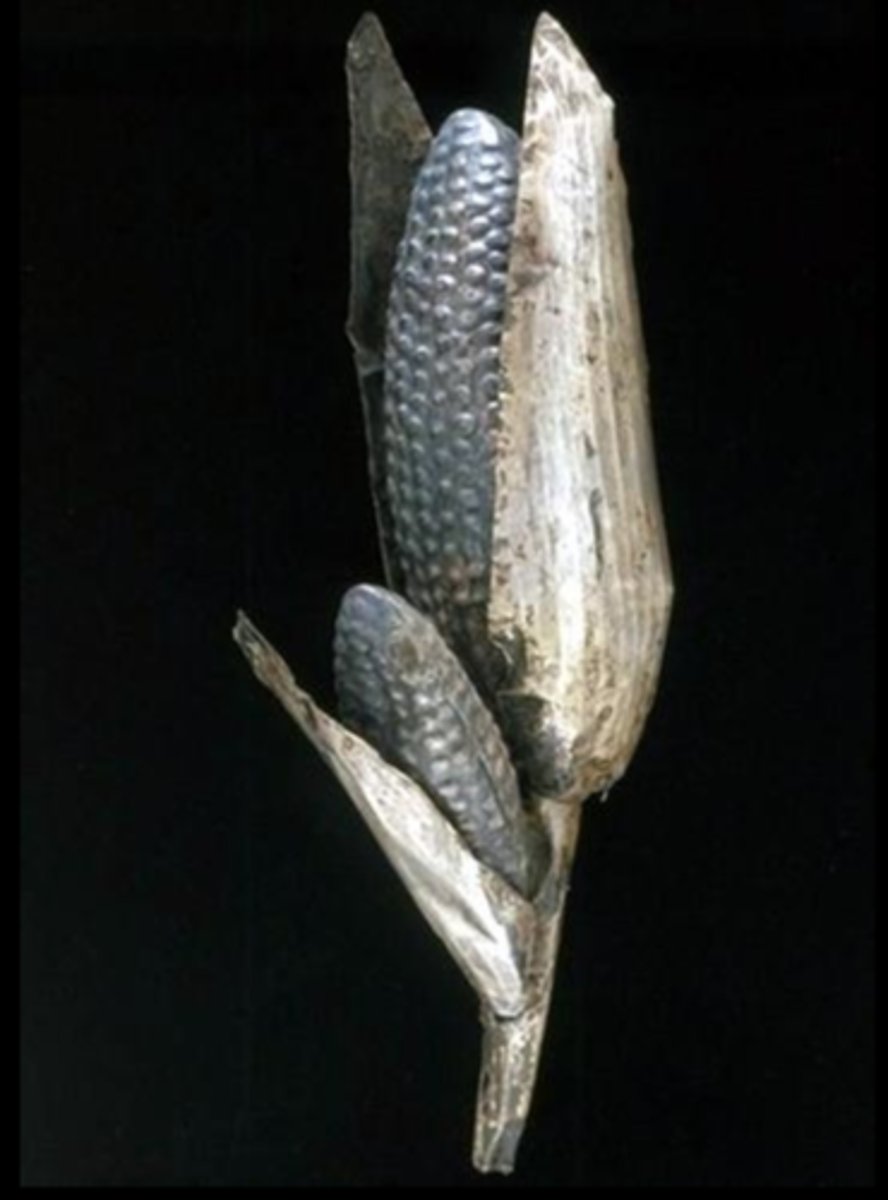
Mesa Verde cliff dwellings
Montezuma County, Colorado. Anasazi. 450-1300 C.E. Sandstone.
Form- Carved into cliffs, difficult to access. Hollowed prior, started with adobe buildings, current are masonry with mortar. High elevation= Cold Nights/ Boiling Days, extremely dry. Lined on top of mesas prior, mound under cliffs to protect from weather.
Function- The shield from weather and guard from attacks. Kivas for healing ritural or rain, crops and harvest. Sacred living space.
Content- 150 rooms, varies 1-4 stories round open Kivas for rituals. Murals: plastered wall w/ murals painted atop display geometric designs, animals and plants, painted with natural pigments. Design similar to those painted by
Pueblo-ans on pottery (ancestory).
Context: Anasazi are now Ancestral Pueblo-ans. Built by Anasazi around 450 C.E., Abandoned by 1100-1200 BCE due to extensive drought (1276-1299) and Social/Political disbandment. Unlike Inca, Aztecs, or Maya, Ancestral Pueblo-ans were egalitarian, without royal higher class
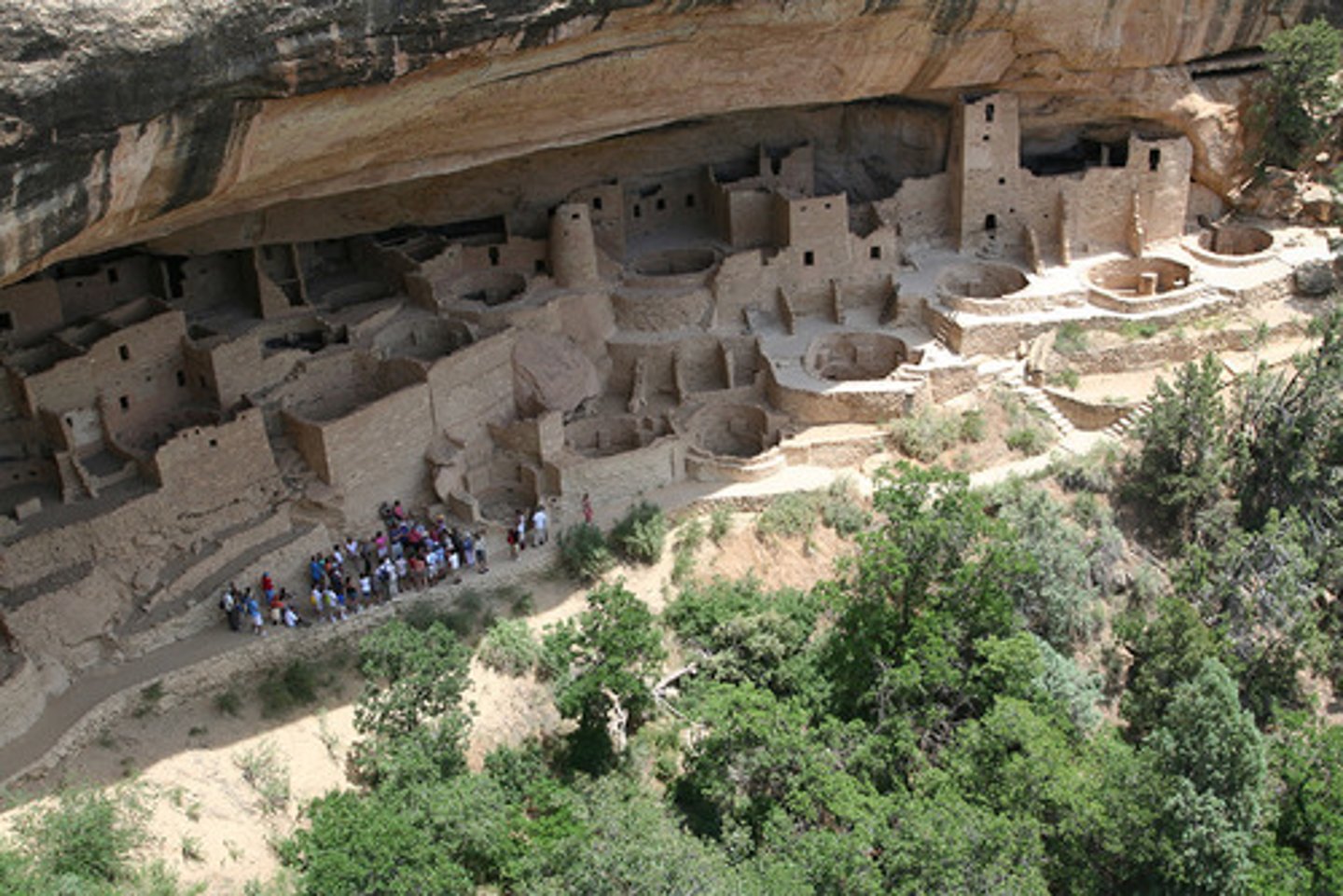
Cusco, including Sasqa Wayman and Qorikancha,
c. 1440-145o, Inka, Peru
Form- Structure of city resembles Giant Puma, 42 sight lines, Qorikancha at center/sight line of 42 other Inca shrines, making it an Axis Munde. dived into upper and lower sections, elites above, commoners below. No mortar, terrising trapezoidal windows. 11k feet, 2k taller than Picchu.
Function- Fortress, High, Zig-Zagging walls with Intihuana in it
Content- Qorikancha= Golden House, Most sacred shrine in the Incan Empire. Originally, outside covered in sheets of gold, became the sun on earth. Building dedicated to sun god with shrine and garden, windows, caught lit on summer solstice to shrine on his throne.
Context- Local leaders were required to live in Cuzco, where empire was run, kept control over leaders. Hierarchical run from One urban center.
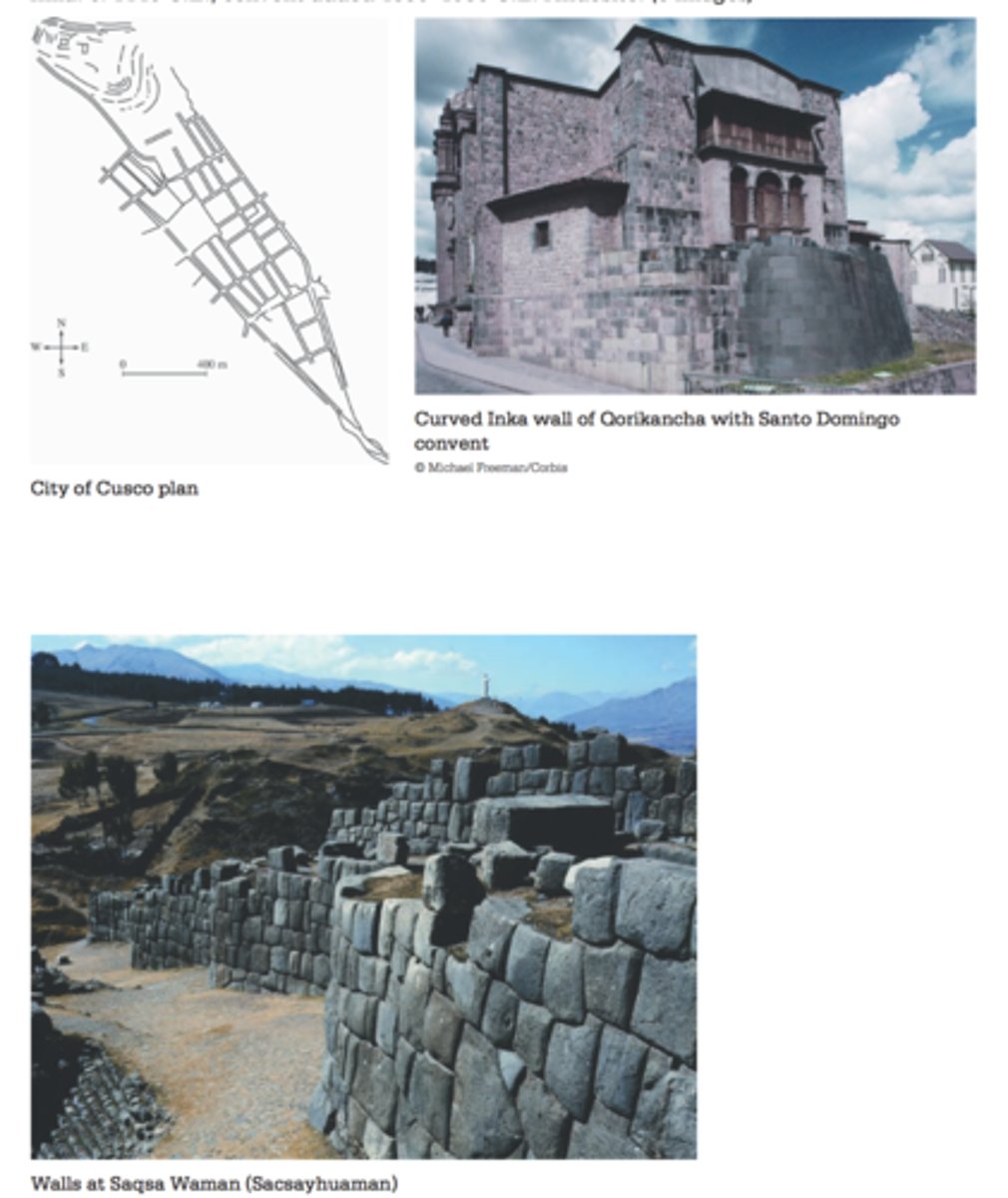
Hide painting of Sun Dance
Eastern Shoshone (Wind River Reservation, WY), attributed to Cotsiogo, c. 1890-1900, Painted Elk Hide
Form- Multiple colors, Painted elk hide, tepees and chief in center, abstract humans and rainbow horses.
Function- Initially traditional practice, here it is Purely decorative and to sell.
Content- Sundance ritural taking place in center, a sacrifice, most sacred ritural of the Plains Indians, to offer thanks to creator and asking for favor. Endurance- A group of men danced facing poled bison head for 4 days without sustiances. Visions from exertion were spiritual.
Context- During Indian removal, the U. S. Outlawed the Sundance. Originally, these paintings were on bison hide, painted with naatural colors. By late 1800s, Shoshone owuld buy hides and use commercial paints for these pieces. Cotsiogo (artist) Hide paintings produced for tourists.
Indian Removal: Nostalga of Europeans wanting images of the traditional Native life, before they changed it. Imagery doesn't reflect the current culutre, but is Nostalga based; Bison were nearly extinct at time. Painted without reality to be commercial valuable to tourists and collectors.
